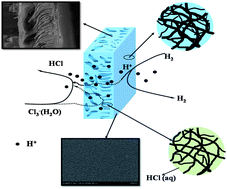Poly(ether sulfone)–sulfonated poly(ether ether ketone) blend ultrafiltration/nanofiltration-based proton-conductive membranes with improved performance for H2/Cl2fuel cell application
Abstract
A new blend ultrafiltration (UF)/nanofiltration (

* Corresponding authors
a
Fuel Cell System and Engineering Laboratory, Dalian Institute of Chemical Physics, Chinese Academy of Sciences, Dalian 116023, China
E-mail:
zhouli@dicp.ac.cn, zhgshao@dicp.ac.cn
Fax: +86-411-84379185
Tel: +86-411-84379123
b Graduate University of Chinese Academy of Sciences, Beijing 100039, China
A new blend ultrafiltration (UF)/nanofiltration (

 Please wait while we load your content...
Something went wrong. Try again?
Please wait while we load your content...
Something went wrong. Try again?
S. Liu, L. Zhou, P. Wang, L. Zhang, Z. Shao and B. Yi, J. Mater. Chem., 2012, 22, 20512 DOI: 10.1039/C2JM33804A
To request permission to reproduce material from this article, please go to the Copyright Clearance Center request page.
If you are an author contributing to an RSC publication, you do not need to request permission provided correct acknowledgement is given.
If you are the author of this article, you do not need to request permission to reproduce figures and diagrams provided correct acknowledgement is given. If you want to reproduce the whole article in a third-party publication (excluding your thesis/dissertation for which permission is not required) please go to the Copyright Clearance Center request page.
Read more about how to correctly acknowledge RSC content.
 Fetching data from CrossRef.
Fetching data from CrossRef.
This may take some time to load.
Loading related content
